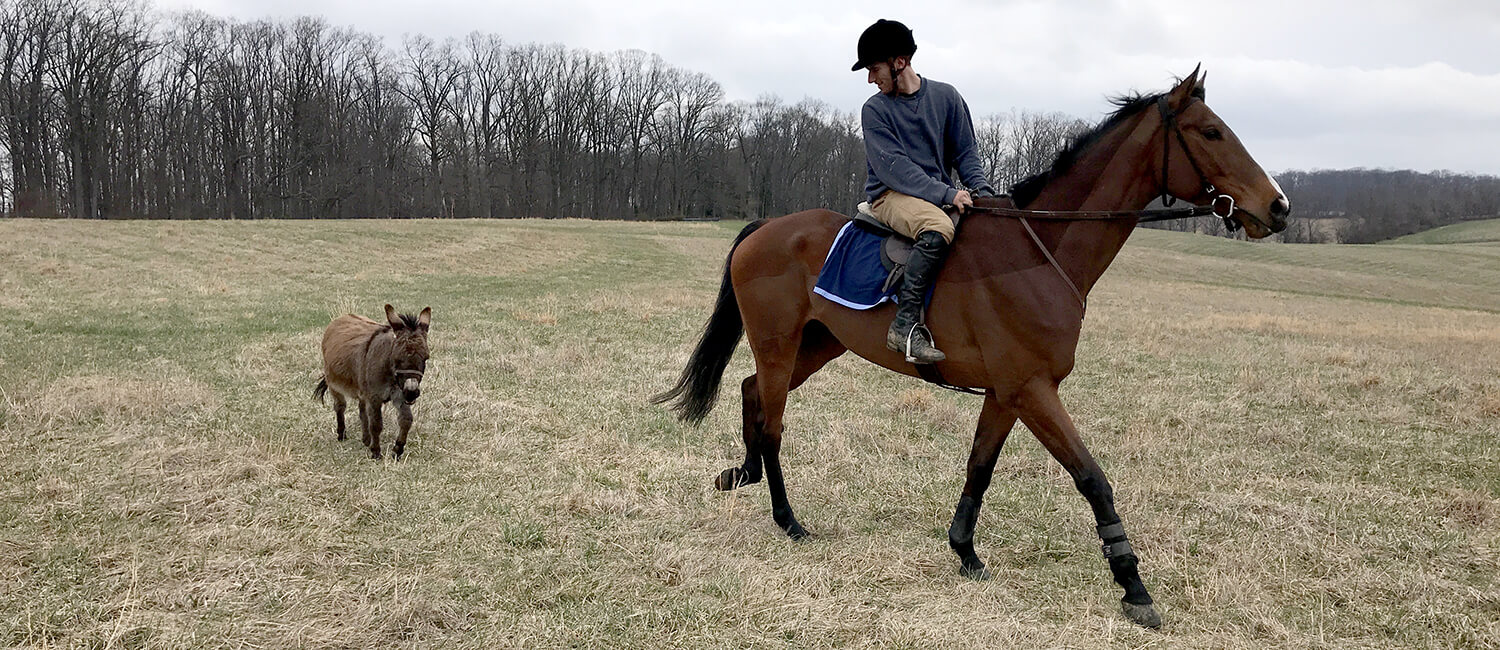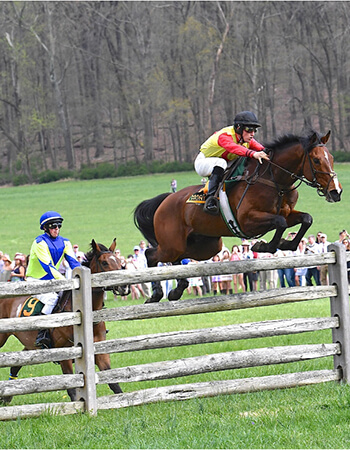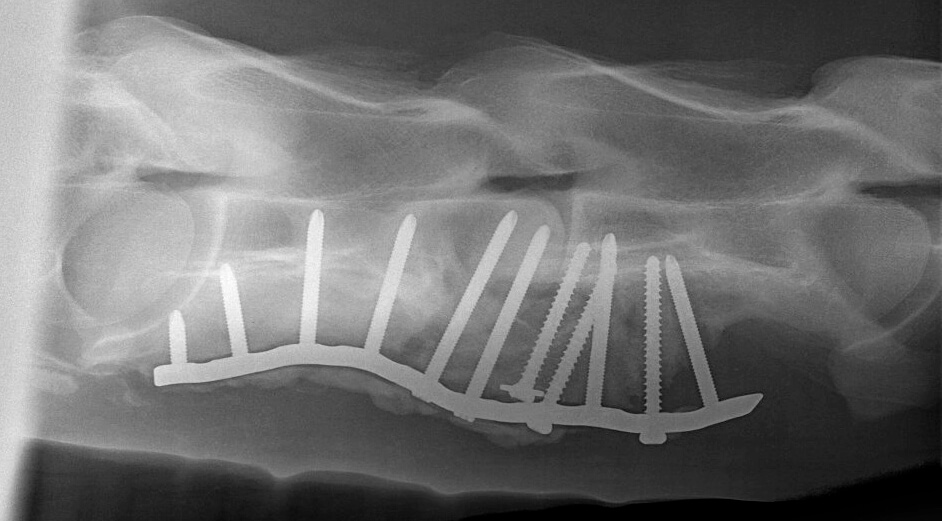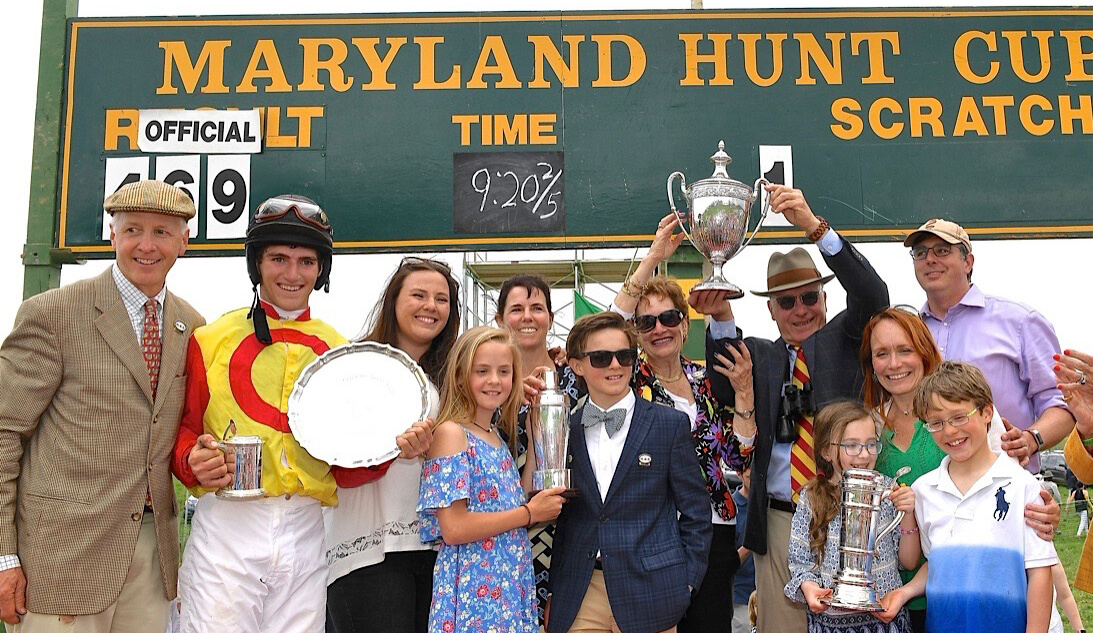 Senior Senator and jockey Eric Poretz are followed on their walk by Senior Senator's pet donkey Fernando.
Senior Senator and jockey Eric Poretz are followed on their walk by Senior Senator's pet donkey Fernando.
Senior Senator has been called “one of the craziest horses that ever looked through a bridle.”
But a serious accident in May 2017 temporarily dampened some of the eight-year-old gelding’s fiery, unique personality, nearly ending his racing career. While defending his 2016 Maryland Hunt Cup title at the 2017 race, the Thoroughbred and jockey Eric Poretz tumbled at the third fence in the notoriously challenging four-mile timber course.
“After the fall, Senior Senator jumped up and galloped to the receiving barn,” said Vicki Crawford, who owns the horse with her husband Irvin “Skip” Crawford. “Because he was so quick to run off, we didn’t think too much of the fall. It really wasn’t until we saw close-up photos of the accident that we realized how serious it was.”
Veterinarian Dr. Cooper Williams, VMD, the horse’s regular doctor and onsite medical staff at the annual race, was concerned right after the tumble. “It’s not unusual with rotational falls involving the head and neck for a horse to appear relatively normal clinically,” said Williams, V’85. “Because of this, we strongly recommend x-rays of the neck after a major fall. Early diagnosis can prevent disasters.”
In Senior Senator’s case, the Crawfords and trainer Joe Davies readily agreed. Due diligence paid off when Williams diagnosed a serious fracture of the neck, involving the fourth and fifth cervical vertebrae. He immediately emailed the images to Dr. Dean Richardson, Charles W. Raker Professor of Equine Surgery, at Penn Vet’s New Bolton Center, and called Richardson to discuss a possible surgical repair.
“Worldwide, Dean is one of the top orthopedic specialists for equines,” said Williams. “And he’s an expert at working in complicated anatomical regions of the horse.”
Robotic Input
In Kennett Square, Richardson reviewed Williams’ referral x-rays that showed a fracture of the fourth cervical vertebra. “This was a horrible crash, really horrific,” recalled Richardson. “But I saw a more than reasonable chance of successfully repairing the injury with surgery.”
Senior Senator traveled to New Bolton Center, where Richardson used the School’s robotics-controlled computed tomography (CT) system to obtain the precise details of the break. Penn Vet is the first veterinary teaching hospital in the world to use the revolutionary equipment that enables clinicians to exam an awake, moving, and weight bearing horse.
“Providing 3D images, this technology offers us tremendous advantages over traditional x-ray and other imaging options,” said Richardson. “And we can evaluate our patient and plan for surgery without having to put the horse under anesthesia, which is a big deal.”
Forearm Length Procedure
 On the day of surgery, Senior Senator was fitted into a large sling attached to an electric hoist. “The sling allows us to control a horse’s movement when we administer anesthesia so we can transition the animal from standing to lying down without injury,” said Richardson. “And when the horse wakes, we can control standing as well.”
On the day of surgery, Senior Senator was fitted into a large sling attached to an electric hoist. “The sling allows us to control a horse’s movement when we administer anesthesia so we can transition the animal from standing to lying down without injury,” said Richardson. “And when the horse wakes, we can control standing as well.”
Once anesthetized, Senior Senator was placed on his back. Richardson and his team used a large fluoroscope — a movie like x-ray machine that shows images in real time — to mark and make incisions on the horse’s neck and sternum.
After opening the targeted area, they then cleared a path to the spine. “We used retractors to move the important and very vulnerable internal parts of the body —like the trachea, carotid artery, jugular vein, and esophagus out of the way,” Richardson explained.
With careful precision, Richardson reached into Senior Senator’s neck at least the length of a forearm to repair the break. The team first removed a large amount of painful disc material between the end plates of the fractured bone and used screws to stabilize the fourth and fifth vertebrae. They then packed the space between the vertebrae with bone grafted from the horse’s sternum, locking everything into place with a stainless-steel compression plate and carefully closing the incision.
“Spa” Time
Recovery for an anesthetized animal weighing over 1200 pounds is tricky to manage. Penn Vet’s landmark recovery pool, part of New Bolton Center’s surgical suite in the C. Mahlon Kline Orthopedic & Rehabilitation Center, makes the transition from unconsciousness to consciousness much safer.
Asleep and in the sling, Senior Senator was moved from the operating room to the recovery pool and lowered into a very large rubber raft with four extensions that contain the horse’s legs. The anesthesia wore off while he was floating in the pool.
“We keep the temperature of the pool very close to the horse's body temperature. Otherwise, the animal will get chilled and not wake properly,” Richardson said. “Basically, to the horse it feels kind of like a spa.”
Typically, a horse remains in the recovery pool for an hour or two. When it wakes, the water gets to work. “Horses are prey animals, so they want to run away as fast as possible when they feel fear,” Richardson continued. “But post-surgery, if they don’t have full neuromuscular control they’ll flail, increasing the chances of falling and re-fracturing the neck. The water provides resistance, keeping horses from flailing. In the pool, they quickly realize there’s not much they can do and usually just chill out.”
Senior Senator adapted well to the pool. Once he was fully alert, the team used the sling to move him to the recovery stall, where they carefully lowered him 15 feet to the floor and removed the sling.
“He was immediately comfortable after the surgery,” Richardson noted. “And his aftercare recovery could not have gone better. He was a perfect patient. He acted like he knew we were helping him and didn’t fight us at all.”
 This radiograph taken seven months after surgery shows the screws used to repair Senior Senator's fracture.
This radiograph taken seven months after surgery shows the screws used to repair Senior Senator's fracture.
Champion Once and Again
“This surgery saved Senior Senator’s life,” said Crawford of the May 2017 procedure. Richardson credits the full surgical team for its success, including New Bolton Center’s anesthesiology nurses, Dr. Kyla Ortved, Assistant Professor of Large Animal Surgery, and Dr. Thomas Schaer, Director of the Comparative Orthopedic Research Laboratory.
Over the course of 12 months, Senior Senator’s recovery progressed at Davies’ farm under the watchful eyes of his extended care team — Richardson, Williams, Davies, and the Crawfords. All were hopeful that this special horse would race again. At the same time, they were prepared to accept he’d had a great flash of glory and might retire a one-time Maryland Hunt Cup winner, the youngest in 50 years.
Like always, Senior Senator had his own plan — he wasn’t ready to bow out quite yet. A year after his terrible accident, in a brilliant comeback, the champ took home the 2018 Maryland Hunt Cup.

After the 2018 Maryland Hunt Cup win: L-R, Joe Davies, Eric Poretz, Sabrina Moore, Blythe Miller Davies with children Scarlet and Teddy, Vicki and Skip Crawford, Camille Crawford Finley and Fritz Finley with Graeme and Vivien. Photo taken by Robert Keller.